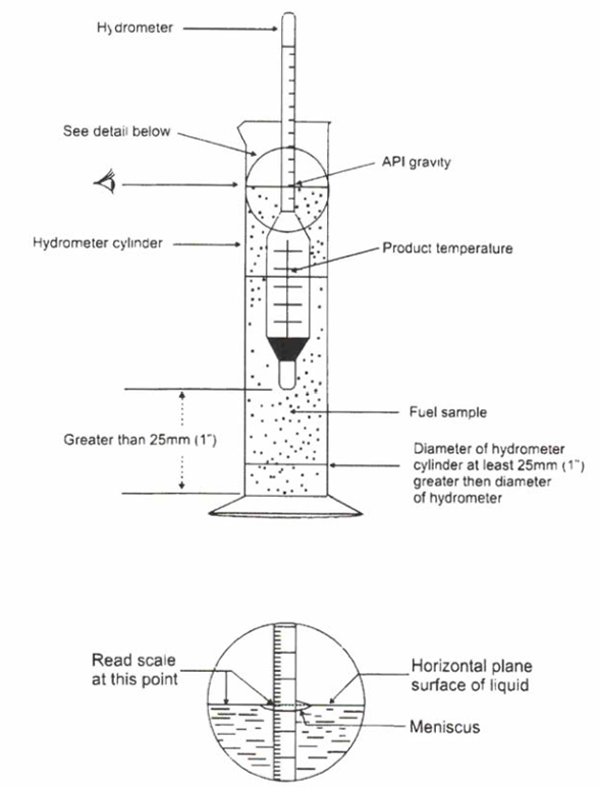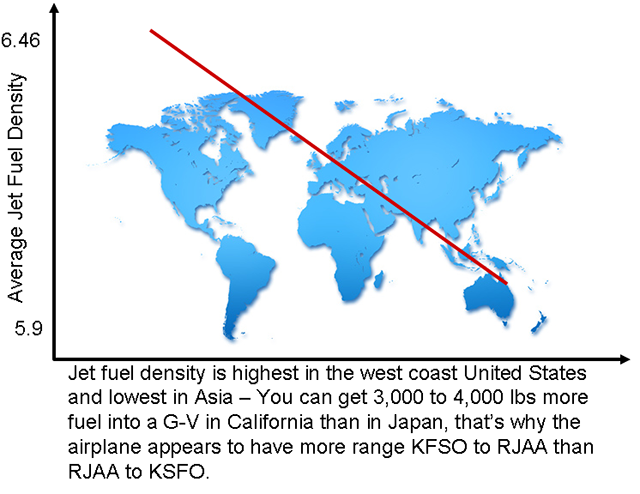Before clicking on to another page, consider this: fuel density makes the difference between making Point A to Point B for any airplane that flies more than an hour away from home. This makes a difference for any long haul airplane.
— James Albright

Updated:
2019-02-03
We flew the GV for years knowing that we could do San Francisco to Tokyo non-stop even with a headwind, but the return trip was not always possible. We couldn't ever put on a full load of fuel in Japan but gallons are gallons, right? As it turns out, fuel density was the culprit and nobody knew that until Gulfstream did a study and released the results in the October 28, 2005 Breakfast Minutes. As it turns out, "The aircraft range is determined by fuel weight, not volume," so if your gauges say you have less gas, chances are you do.
If you are planning on flying to the airplane's maximum range you need to understand fuel density, especially if operating out of Asia.
Our Boeing 747's had a total fuel capacity of 300,000 lbs, which meant a lot of range. But sometimes we ended up with a lot of extra range or a lot less. We didn't understand fuel density as well as we should have. To us, density was a puzzle.

1
Fuel density defined
- Scientific definition of density: density (ρ) of a body is the ratio of its mass (m) to its volume (V).
- Density of fuel is “the mass of fuel per unit volume”.
- In some cases the density is expressed as a specific gravity or relative density, in which case it is expressed in multiples of the density of some other standard material, usually water or air.
- Reference: ASTM D1655 specification, Jet A-1 fuel has a density of between 775.0 and 840.0 kg/m3. Density ranging from 37 to 51 °C API corrected to 15 °C or 60 °F.
Source: Fuel Handling Jet Quality and Test Procedure, ¶1.6
When it comes to fuel, higher density means more "bang for the buck." The density is determined by the quality of the crude used to produce the fuel and the refining process.
2
Measuring fuel density
Fuel density is usually measured with a hydrometer, which is nothing more than a glass tube with a weighted bottom that sinks to a level proportional to the density of the liquid. The hydrometer is calibrated against a scale used to determine the density for a given temperature.

Fuel density hydrometer, from Fuel Handling Jet Quality and Test Procedure, figure 1.8.
3
Fuel density vs. weight
Using a fuel density of 6.75 pounds per gallon at 60°F, the total usable fuel capacity of a G450 is 29,500 lb. (13,380 kg), for a total of 4,370 US gallons (16,542 liters). It is permissible to exceed 29,500 lbs of fuel (due to fuel densities) so long as the maximum ramp and takeoff weights are not exceeded.
All that being said, why is it that you cannot always get 29,500 lbs or 4,370 US gallons on the airplane?
The variables include:
- Aircraft attitude during refueling
- Wing volume
- Fuel Quantity Measuring System (FQMS) accuracy
- Fuel temperature
- Fuel density
Gulfstream conducted a study on this subject when the GV was the queen of the fleet, but the lessons learned apply to the G450 as well. For the sake of the study, keep in mind a GV's published fuel capacity is 41,300 lbs.
4
Impact comparisons
Aircraft Attitude Impact on Fuel Capacity
The GV's fuel capacity was designed with the aircraft attitude at 1-1/2° nose down, but the maximum variation due to ramp attitude was found to be only 22 gallons / 148 pounds.
Wing Volume Impact on Fuel Capacity
Aircraft since GV sn 529 have been tested for full volume capacity and found "satisfactory."
FQMS Accuracy Impact on Fuel Capacity
The design specification of the FQMS is ±300 lbs. Typical performance is ±200 lbs. Spot checks have been found "satisfactory."
Fuel Temperature Impact on Fuel Capacity
The Gulfstream GV study revealed that each 10°F increase in fuel temperature reduced the GV's fuel capacity by 200 lbs. The variation between -20°C and +50°C, for example, can be almost 1,400 lbs.
Using these numbers, a G450's published capacity of 29,500 lbs (4,370 US Gallons) at 60°F will drop to 28,900 lbs at 90°F.
Fuel Density Impact on Fuel Capacity
Fuel density has the greatest impact on fuel capacity. A GV's maximum fuel volume is 6,118 USG, this does not change. Variation in world fuel density can cause the GV's maximum fuel capacity to change more than 5,000 lbs.
Jet-A fuel density limits are established by the American Society for Testing and Materials (ASTM) Specification D1655. At 60°F the density limits are from 6.46 to 6.99 lbs/gallon.
In a G450, this equates to a range of:
- 28,230 lbs at 6.46 lbs/gallon
- 30,546 lbs at 6.99 lbs/gallon
A variation of 2,316 lbs.
Surveys reveal this trend:
5
Example fuel density charts
Michael McLeod has gone through the work on a few aircraft to provide fuel density charts.
References
(Source material)
Fuel Handling Jet Quality and Test Procedure, PetroValue Aviation, 2008-2
Gulfstream Breakfast Minutes, GV/G500/G550 (ATA 28) Fuel Density Variations, October 28, 2005
Please note: Gulfstream Aerospace Corporation has no affiliation or connection whatsoever with this website, and Gulfstream does not review, endorse, or approve any of the content included on the site. As a result, Gulfstream is not responsible or liable for your use of any materials or information obtained from this site.

